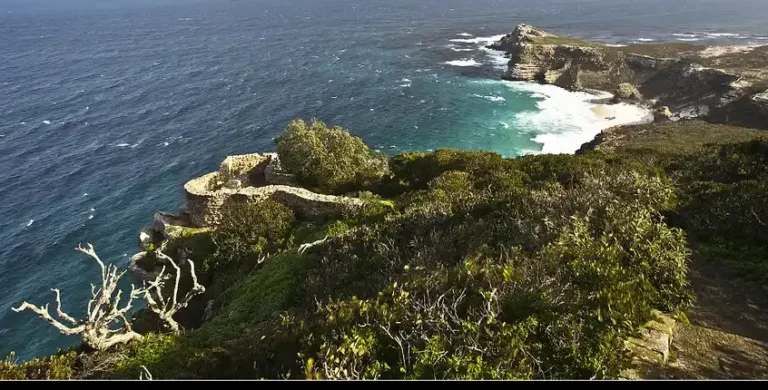Cape Point offers stunning views that captivate nature lovers and adventure seekers alike. This iconic destination, located at the southern tip of the Cape Peninsula, boasts dramatic cliffs and sweeping ocean vistas. Whether you hike its trails or take in the sights from the lighthouse, the beauty is breathtaking. This post will guide you through the best viewpoints and experiences Cape Point has to offer, ensuring you don’t miss the incredible sights while surrounded by nature.
Quick Summary
Explore Cape Point, located at the southernmost tip of the Cape Peninsula in South Africa, is an unparalleled destination for nature lovers, adventure seekers, and photographers alike. Its awe-inspiring landscapes, diverse wildlife, and breathtaking ocean views draw visitors from across the globe. Whether you are interested in hiking, photography, or simply soaking in the panoramic vistas, Cape Point offers an unforgettable experience.
This guide takes you through the myriad of attractions Cape Point has to offer, highlighting its iconic views, thrilling activities, and unique wildlife encounters. We’ll also provide comparisons, testimonies, and essential travel tips to ensure you make the most of your trip to this stunning natural wonder.
Introduction
Cape Point, one of South Africa’s most iconic landmarks, is where the land meets the sea in a dramatic convergence of cliffs, waves, and sky. Often referred to as the “Cape of Storms” by sailors, this unique location at the southernmost tip of the Cape Peninsula offers more than just a pretty view. It is steeped in history, surrounded by rich biodiversity, and is part of the Table Mountain National Park, a UNESCO World Heritage Site.

Cape Point is known for its sweeping ocean vistas, jagged cliffs, and the feeling of standing at the edge of the world. While it’s often mistaken for the southernmost tip of Africa (that title goes to Cape Agulhas), Cape Point is the more famous of the two and captivates travelers with its unrivaled natural beauty and million-dollar views. Whether you’re hiking up to the old lighthouse, enjoying the panoramic views, or discovering the local wildlife, every corner of Cape Point is a visual treat.
The Iconic Attractions of Cape Point
1. The Old Lighthouse
Perched 238 meters above sea level, the Old Lighthouse at Cape Point was built in 1859 and remains one of the most recognizable features of the landscape. While no longer operational, it offers panoramic views of the surrounding oceans and cliffs. Visitors can hike up to the lighthouse or take the Flying Dutchman Funicular for an easier ascent.

At the top, you’ll be rewarded with spectacular views of the surrounding landscape and coastline, extending all the way to False Bay. On a clear day, the views from the lighthouse are among the best in the Cape Point region.
2. Cape of Good Hope
The Cape of Good Hope is another iconic attraction located within the Cape Point Nature Reserve. Known for its rugged cliffs, this spot has long been a symbol of exploration and maritime adventure. Visitors flock to the sign marking the Cape of Good Hope to take photos and enjoy the breathtaking coastal scenery.

The Cape of Good Hope is also a fantastic spot for hiking, with several trails leading to scenic viewpoints and hidden beaches. One of the most popular is the Cape Point to Cape of Good Hope trail, a moderate 1.5-hour hike that offers stunning views of the ocean and surrounding cliffs.
3. Dias Beach
Located beneath the towering cliffs of Cape Point, Dias Beach is one of the area’s hidden gems. Tucked away and often less crowded than other beaches, it offers pristine white sands and a perfect spot for a quiet picnic or a photo opportunity. While swimming is not recommended due to strong currents, the beach is ideal for a peaceful escape from the busier parts of Cape Point.

To reach Dias Beach, you’ll need to walk down a steep set of stairs from the cliffs above. The effort is worth it, as you’ll be greeted by one of the most picturesque and untouched beaches in South Africa.
4. Flying Dutchman Funicular
For those who prefer not to hike to the top of Cape Point, the Flying Dutchman Funicular is a convenient and enjoyable way to reach the Old Lighthouse. This funicular takes passengers from the lower station to the top, offering stunning views of the ocean and surrounding cliffs along the way.

Named after the legendary ghost ship that is said to haunt the waters around Cape Point, the funicular adds an extra layer of mystique to your visit. The ride is short but memorable, providing a comfortable alternative to walking while still allowing you to enjoy the incredible scenery.
Wildlife Encounters
Cape Point is home to an incredible array of wildlife, from antelope and ostriches to rare bird species and the iconic Cape Mountain zebra. The surrounding waters also attract a variety of marine life, including dolphins, seals, and even whales during the migration season.
1. Baboons

While exploring Cape Point, you’ll likely encounter the area’s famous chacma baboons. These intelligent and curious animals can often be seen along the roadside or in the picnic areas. Although they are fascinating to observe, it’s important to remember that baboons are wild animals, and feeding them is strictly prohibited.

2. Bird Watching
Cape Point is a paradise for birdwatchers, with over 250 species of birds recorded in the area. The cliffs provide nesting sites for several seabird species, including the Cape Gannet and African Black Oystercatcher. If you’re lucky, you may also spot the majestic Verreaux’s Eagle soaring high above the cliffs.


3. Whale Watching
From June to November, Cape Point becomes a prime spot for whale watching. Southern right whales migrate to the area’s warm waters to breed and give birth, providing visitors with incredible sightings from the cliffs. Keep an eye out for their characteristic blows, breaching, and tail slaps as they play in the waters below.

Visit Cape Point: Where Each View Tells a Story
Standing at Cape Point feels like being on the edge of the world. The Cape Point views are breathtaking, with dramatic cliffs meeting endless ocean. From iconic Cape Point attractions to hidden trails, every visit is unforgettable. Curious about the best time to visit Cape Point or how to plan Cape Point tours? Let’s make your trip unforgettable.
Cape Point isn’t just a place; it’s an experience. From sweeping landscapes to history-rich spots, it’s packed with must-see Cape Point attractions. Whether you’re chasing epic Cape Point views or wondering about the best time to visit Cape Point, this guide has you covered. Let’s get started on planning your adventure.
Comparison: Cape Point vs. Cape Agulhas
Many visitors to South Africa are often confused about the difference between Cape Point and Cape Agulhas. While both are iconic destinations, they offer different experiences.
Cape Point
- Pros:
- Stunning ocean views from high cliffs.
- Rich wildlife and diverse hiking trails.
- Historical significance with the Old Lighthouse and maritime history.
- Cons:
- Often crowded with tourists.
- Windy conditions can make some areas uncomfortable for extended stays.
Cape Agulhas
- Pros:
- The true southernmost point of Africa.
- Quieter and less touristy compared to Cape Point.
- Features a beautiful lighthouse and the meeting point of the Indian and Atlantic Oceans.
- Cons:
- Lacks the dramatic cliffs and panoramic views of Cape Point.
- Fewer hiking opportunities and wildlife encounters.
If you’re looking for dramatic vistas and adventure, Cape Point is the clear winner. However, for those seeking a quieter, more reflective experience, Cape Agulhas might be more suitable.
Testimonies
Sophia M., Tourist from Germany:
“Cape Point was the highlight of our South African trip! We took the funicular to the top, and the views were absolutely breathtaking. Standing on the edge of those cliffs made us feel like we were at the end of the world. We even spotted some whales from the viewpoint. Highly recommend it!”
Jared T., Hiker from the USA:
“The hike from Cape Point to the Cape of Good Hope was challenging but so worth it. Every step gave us a new view of the ocean and cliffs. Dias Beach was a hidden gem, and we had it almost to ourselves. Definitely a must-do for any nature lover!”
Explore Cape Point
Cape Point is a destination that exceeds expectations at every turn. The blend of striking natural beauty, rich history, and an abundance of wildlife makes it one of the most rewarding travel experiences in South Africa. From the moment you step onto its windswept cliffs and gaze out at the endless ocean, you’ll be captivated by its rugged charm.
Although it can get crowded, the sheer size of the area ensures that there are always quiet spots to enjoy. Whether you’re hiking along the cliffside trails, taking in the sweeping views from the lighthouse, or discovering the hidden gems like Dias Beach, Cape Point offers something new around every corner. Its pristine environment, fascinating wildlife, and dramatic landscapes make it a must-see destination for any traveler to South Africa.
Pros and Cons
Pros:
- Stunning Panoramic Views: Cape Point offers some of the most breathtaking ocean views in South Africa.
- Rich History and Heritage: From the Old Lighthouse to the Cape of Good Hope, Cape Point is steeped in maritime history.
- Varied Wildlife: The chance to encounter baboons, birds, and even whales makes it a wildlife lover’s paradise.
- Diverse Hiking Opportunities: The area boasts a variety of trails catering to all levels of fitness.
Cons:
- Crowds: As one of South Africa’s top tourist destinations, it can get quite busy, especially during peak season.
- Windy Conditions: The area is known for its strong winds, which can sometimes make outdoor activities less comfortable.
- Cost: Entrance fees and funicular tickets can be expensive, especially for larger families.
Rating:
8/10 – Cape Point offers an unforgettable experience for nature lovers and adventure seekers, though the crowds and high winds might be drawbacks for some visitors.
Conclusion
Cape Point is an extraordinary destination that combines the raw beauty of nature with rich cultural history. Whether you’re exploring the cliffs, enjoying the ocean views, or observing the local wildlife, Cape Point promises an experience that is both humbling and awe-inspiring. Its scenic vistas, diverse activities, and proximity to Cape Town make it a must-visit destination for anyone traveling to South Africa.
FAQs
Q: What is the best time of year to visit Cape Point?
A: The best time to visit Cape Point is during South Africa’s spring and summer months (September to March) when the weather is mild, and the skies are clear. Whale watching season runs from June to November.
Q: How much time should I spend at Cape Point?
A: Most visitors spend around 3-4 hours at Cape Point to explore the main attractions. However, if you plan on hiking or enjoying a picnic, you might want to allocate more time.
Q: Is Cape Point family-friendly?
A: Yes! Cape Point offers family-friendly activities like the funicular ride, easy walking trails, and picnic spots. However, keep an eye on younger children near the cliff edges, and be aware of the baboons in the area.
Q: Can I swim at Dias Beach?
A: While the water at Dias Beach may look inviting, swimming is not recommended due to strong currents and rough seas.
Q: Is Cape Point accessible by public transport?
A: While there are some tour companies that offer transport to Cape Point, it is best reached by car. A day trip from Cape Town is a popular option for visitors.




